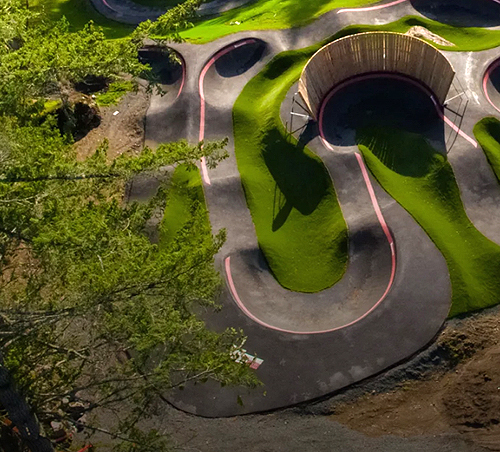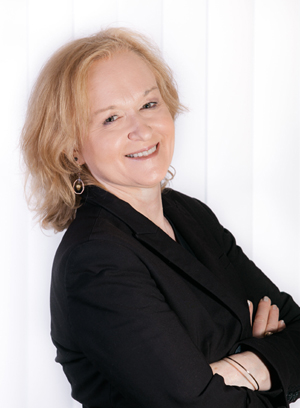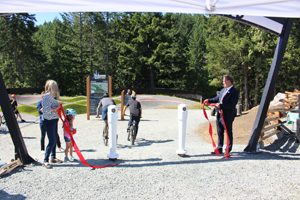
Friday June 25, 2021 | LANGFORD, BC [another photo added July 3, 2021]
INSIGHTS & COMMENTARY by Mary P Brooke, Editor | Island Social Trends
The Jordie Lunn Bike Park in Langford was officially opened on May 28, as proudly stated by the city’s Parks, Recreation, Culture & Beautification Committee Chair Lanny Seaton at last night’s meeting. For some reason a more toned-down splash was also held at the bike park this week on June 22, with some swag leftovers.

Maybe the repeat-performance to introduce the Jordie Lunn Bike Park had something to do with the BC Restart now being in Step 2 (as of June 15) with regard to COVID-related public health restrictions (a loosening up on public gatherings at this stage). But likely it’s much more to do with how Langford does things…. the close-knit crowd first, then perhaps others.
The former might seem intimate and celebratory to the inside players, but the reverberation of a ‘closed shop’ feeling in the fast-growing community (as sometimes noted by politicians outside the force field) still remains. Every organization and government has a hierarchy, but that’s not the same as exercising a pecking-order. It’s a part of why in the past year there’s been a groundswell of political push-back (built up over years), notably with the highly organized Langford Voters for Change group. The Langford Voters for Change group now oddly seems to be entwined within the city’s projects, with key players such as a planner who works for the Capital Regional District (CRD) and even one of the SD62 school board trustees — is this protest or infiltration?
Dealing with push-back:
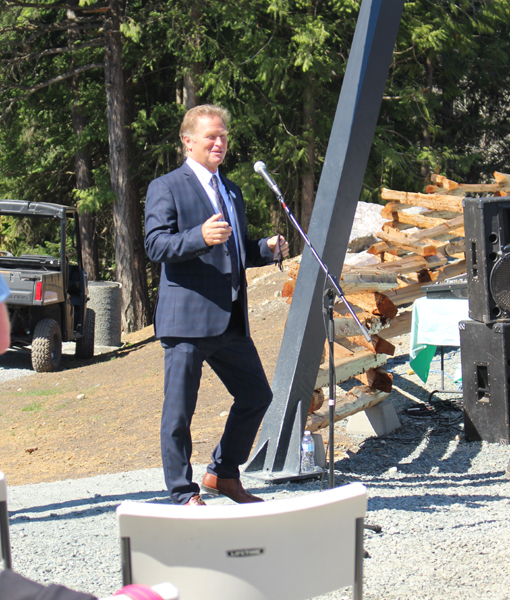
There’s nothing conventional about the City of Langford in dealing with the evident push-back; in terms of adaptation, that’s taken care of by the ‘whatever it takes’ mantra of Langford Mayor Stew Young. But Langford still remains entirely conventional in that politics are done rigidly in a way that produces a feeling of exclusion or take-down of players who appear (from the insider’s view, or those who feel threatened by change) not to fit; it could even be said to be a long-time echo of the colonialism that is very much embedded in the way Canadian politics and institutions have evolved (seen very much under siege nowadays across the country). The sense of exclusion in Langford even impacts neighbourhoods that just happen to lie in the path of the grand-vision steamroller, hence the recent organized public push on many issues (the recent public uproar about Fairway Avenue development in the Goldstream Avenue vicinity is just one that comes to mind).
Push-back should come as no surprise (you know, there’s that thing we call yin and yang). To give some benefit of the doubt, things seem to work so well from the inside-looking-out that there was not even awareness of the damage being done beyond the boundary. As the city grows, it will need to mature in how it gets things done, and evidently that needs to be done quickly. The mayor seems to get this all of a sudden, and the public can see things changing, though still awkwardly in fits and starts.
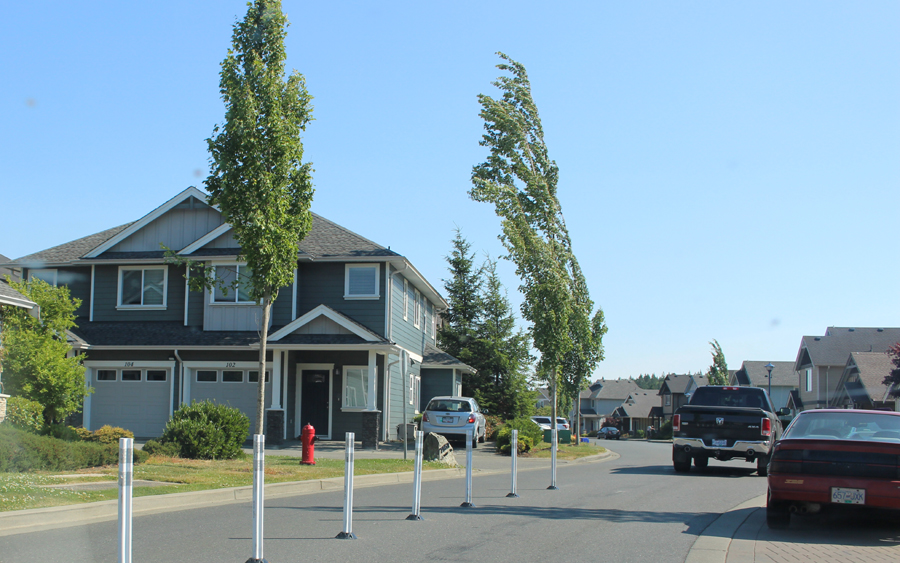
Nevertheless, Langford makes the push-back phenomenon work to their advantage. Case in point, the City noted every detail of complaints made on Monday evening at their June 21 council meeting regarding traffic speed and congestion on Alouette Drive (in old Westhills) and after just three days later there were already perpendicular lane barriers in place and a new stop sign, all exactly where requested by the complainants. “You see, we’re listening”, is the political messaging there, even though Alouette has now instantly lost its ambiance, drivers in larger vehicles are surprised at the new tight laneway that Alouette has suddenly become, and property values will no doubt face challenges.
Maintaining central control:
Where micro-level control probably doesn’t work to Langford’s advantage is in ways that are subtle but deep, in ways that are incalculable. Case in point on that — at Monday night’s council meeting there was an absolute rejection of Langford participating in the Capital Regional District (CRD)’s Arts grants program. Langford understandably says they want control over where the money goes (or, actually from where it comes in — someone on Council on Monday night said staff know how to get grants through the BC Government — i.e. macro level funding related to capital projects and city-run projects).
Long-time Langford City Councillor Denise Blackwell (who also chairs the CRD’s hospital board) was vocal against being part of the CRD arts program which shares funds around the region through an extensive application and adjudication process of artists and art groups as they apply for funds.
Long-time Langford Councillor Lillian Szpak (who chairs the city’s Protective Services Committee but is always vocal about the arts), also voted for rejection of Langford’s participation with the CRD Arts Funding program.

Occasionally those grants end up funding individual artists and small groups who otherwise would not have a shot at creating anything beyond their own studios; without programs like the CRD’s, some creations of art might never see the light of day. The purpose of art is to reveal. Mayor Young says the city will focus on ‘performing arts’ in its own way (lately wooing artists to rent space in the Station Avenue Revitalization District, and seems perhaps more open to giving some rope to the long West Shore Arts Council which has functioned in a hobbled way for years.
The CRD arts program is not perfect by any means (it tends to get tangled up with bureaucracy and some artists still fall between the cracks), but for Langford to reject it wholesale shows that control is still from the top. Community pressure (such as through Langford Voters for Change) is now suddenly enfolded skillfully, without the city losing control. After all, the 2022 municipal election is just around the corner. From a political management perspective, well done.
Bike park a city jewel:
Back to the bike park, within a 160-acre parcel donated by Westhills Land Corp. Named after the late mountain biker Jordie Lunn, it is clearly a masterpiece in that sector of sport. The amount of care, devotion, resource and time put into launching the bike runs and trails within a larger park area as donated by Westhills is clearly evident. To say this outdoor offering of bike trails, walk-through-the-woods park and upcoming clubhouse (containing washrooms, outdoor showers, community meeting space, a concession, bike repair and rental space) will put Langford on the map is an understatement. And it’s clearly a strong draw for Westhills as a community with a decades-long real estate build-out.
The Jordie Lunn Bike Park is a one-of-a-kind recreational cycling facility that caters to cyclists of a variety of ages and abilities. It combines elements of dirt jumping, a pump track, skills area and a cyclocross and mountain bike trail network in one seamless platform. The Jordie Lunn Bike Park has been built to inspire the local community to come together in their love for fun and innovative sport.
The Jordie Lunn Bike Park is yet another trophy creation for Langford, envisioned in large part by the mayor in response to Lunn’s death but also by many staff and people in the community (including many Langford city staffers) who love cycling and high-level performance biking.
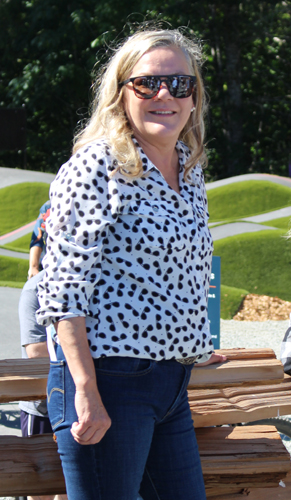
The Jordie Lunn Bike Park fits like a glove into the national sports capital signature that the City of Langford has been building for several years now. There’s a focus on golf, tennis and cycling at Bear Mountain, soccer at the Starlight (formerly Westhills) Stadium and Indoor Training Centre, a range of activities at the City Centre arena, boxing, rock (wall) climbing, rugby, and more. Sports fields are donated or supported by Langford at many schools in the west shore region, integrating itself with youth as they grow into various sport communities. Somehow Langford is achieving a mix of at-home cozy small town while bursting at the scenes to be seen as something of the metaphorical ‘sparkling city on the hill’, a sculpted-by-hand metropolis, unique to its geography, people and ambitions.
There’s a special tone of remembrance at the Jordie Lunn Bike Park with access from Irwin Road in the newer part of Westills. Jordie Lunn’s mother Bonnie was at the June 22 opening to speak with media. If you ask in just the right way, the emotions of losing her son to a sudden biking accident in Mexico in October 2019 swell heavily to the surface. Jordie was the middle child of three, all sons. She tells of how her son grew in the sport from a young age, starting in their backyard and eventually reaching international renown not only as a biker but for also designing bike parks as part of standalone or community-based facilities and attractions.
Unique municipality:
Langford moves forward in many ways, learning as it goes. There is no other city in BC, and possibly Canada, that has expanded so quickly and in so many unique ways.
As the mayor said at last week’s event to officially open Boulder House, it’s because the municipality started out on a shoestring that they learned to be nimble and creative; it was something of an admission to poaching great ideas and running with them. Sometimes that has resulted in being bull-headed and a bit damaging, but now with the might of size and momentum Langford has the luxury to exercise responsiveness where it chooses.
VIP profile:
The June 22 gathering at Jordie Lunn Bike Park was attended by City of Langford Mayor Stew Young and Langford Councillors Denise Blackwell, Lanny Seaton, Norma Stewart and Lillian Szpak; Ryan McKenzie, Manager of Westhills Land Corp (which is owned by the Stewart family); West Shore RCMP Detachment Commander Todd Preston; Langford Fire Chief Chris Aubrey and Deputy-Chief Lance Caven; Dan Matthews of Ecoasis (which owns Bear Mountain); Jim Hartshorne of KeyCorp Developments; Ron Coutre of the WestShore Developers Association; and many others.
===== About the writer:
Mary P Brooke, B.Sc., Cert PR, is the Editor and Publisher of Island Social Trends. Starting with MapleLine Magazine in 2008 (colour glossy, print only), which morphed into Sooke Voice News in 2011 (print and emergent-digital), then to West Shore Voice News in 2014 (print and digital PDF), and last year emerging as Island Social Trends (fully digital), this news publication takes the socioeconomic and sociopolitical viewpoint on things in addition to keeping a finger on the pulse of local goings-on. During COVID we have covered certain aspects of the pandemic intensively. Education news is also a thread.
Island Social Trends is pleased to be part of the very talented and professional journalism community of reporters here on South Vancouver Island. Our readers — and particularly our ENews subscribers who we proudly know to be attentive and responsive — get a different take on the news here in these pages, as a way of rounding out the broader strokes of sociological change in society today.
We offer the Island Social Trends Journalism Scholarship each year.
Island Social Trends is active in the public discourse on Twitter @IslandSocTrends .



